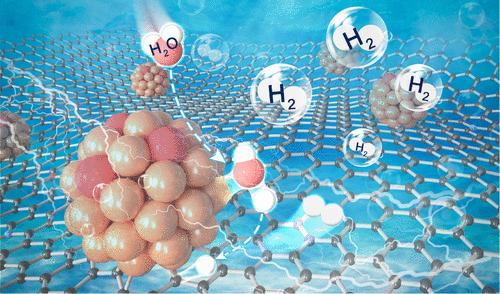原位时间分辨x射线吸收光谱揭示了碲团簇部分再氧化对氢演化延长寿命的影响
IF 15.6
1区 化学
Q1 CHEMISTRY, MULTIDISCIPLINARY
引用次数: 0
摘要
高效和持久的电催化剂是决定其大规模商业可行性的关键因素之一。尽管电催化剂失活和再生的基本原理对于理解和维持持久的活性至关重要,但与金属衍生的催化剂相比,对类金属的研究很少。在此,我们利用原位秒分辨x射线吸收光谱,发现了氮掺杂碳(称为Te-ACs@NC)作为析氢反应(HER)的高性能电催化剂支持的碲团簇在失活-再生循环中的化学演变。通过原位电化学还原,Te-ACs@NC在之前的HER工艺中由于表面相变而失活,在下一次运行中被重新激活和再生,其中部分氧化的Te被发现,令人惊讶的是,比其未氧化状态表现更好。经过连续10次480 h的失活-再生循环后,Te-ACs@NC保持了85%的初始催化活性。理论研究表明,局部氧化调节了单个Te簇内的电子分布,从而优化了水分子的吸附能,降低了解离能。本研究对很少被探索的类金属团簇催化剂失活和再生过程提供了基本的见解,并将有助于未来设计和开发具有高活性和长寿命的负载型催化剂。本文章由计算机程序翻译,如有差异,请以英文原文为准。

In Situ Time-Resolved X-ray Absorption Spectroscopy Unveils Partial Re-Oxidation of Tellurium Cluster for Prolonged Lifespan in Hydrogen Evolution
Efficient and long-lasting electrocatalysts are one of the key factors in determining their large-scale commercial viability. Although the fundamentals of deactivation and regeneration of electrocatalysts are crucial for understanding and sustaining durable activity, little has been conducted on metalloids compared to metal-derived ones. Herein, by virtue of in situ seconds-resolved X-ray absorption spectroscopy, we discovered the chemical evolution during the deactivation-regeneration cycles of tellurium clusters supported by nitrogen-doped carbon (termed Te-ACs@NC) as a high-performance electrocatalyst in the hydrogen evolution reaction (HER). Through in situ electrochemical reduction, Te-ACs@NC, which had been deactivated due to surface phase transitions in a previous HER process, was reactivated and regenerated for the next run, where partially oxidized Te was found, surprisingly, to perform better than its nonoxidized state. After 10 consecutive deactivation-regeneration cycles over 480 h, the Te-ACs@NC retained 85% of its initial catalytic activity. Theoretical studies suggest that local oxidation modulates the electronic distribution within individual Te clusters to optimize the adsorption energy of water molecules and reduce dissociation energy. This study provides fundamental insights into the rarely explored metalloid cluster catalysts during deactivation and regeneration and will assist in the future design and development of supported catalysts with high activity and long durability.
求助全文
通过发布文献求助,成功后即可免费获取论文全文。
去求助
来源期刊
CiteScore
24.40
自引率
6.00%
发文量
2398
审稿时长
1.6 months
期刊介绍:
The flagship journal of the American Chemical Society, known as the Journal of the American Chemical Society (JACS), has been a prestigious publication since its establishment in 1879. It holds a preeminent position in the field of chemistry and related interdisciplinary sciences. JACS is committed to disseminating cutting-edge research papers, covering a wide range of topics, and encompasses approximately 19,000 pages of Articles, Communications, and Perspectives annually. With a weekly publication frequency, JACS plays a vital role in advancing the field of chemistry by providing essential research.

 求助内容:
求助内容: 应助结果提醒方式:
应助结果提醒方式:


